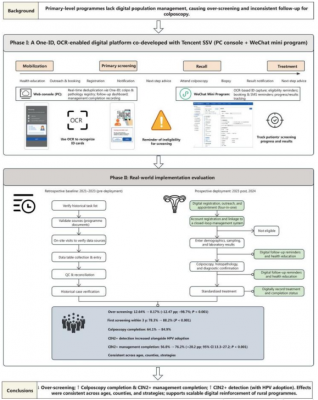Cervical cancer continues to be a significant health challenge, especially in rural areas where access to healthcare resources is limited. Recent evaluations of a digital platform named “One-ID,” developed by the Tencent Inclusive Health Lab, reveal its potential to improve cervical cancer screening processes. This innovative system employs optical character recognition (OCR) technology to enhance detection and reduce unnecessary procedures.
The digital platform aims to streamline the screening process, making it more efficient and accessible. According to researchers, the One-ID system can effectively identify abnormal results from cervical cancer tests, which is crucial for early intervention and treatment. In regions where traditional screening methods may be underutilized or inconsistent, this technology could significantly mitigate the risks associated with late-stage diagnosis.
Cervical cancer remains one of the leading causes of preventable deaths among women globally. The World Health Organization has reported that, despite being largely preventable with proper screening and vaccination, thousands of women continue to lose their lives to this disease every year. The implementation of AI-enabled solutions like One-ID is seen as a vital step towards reducing these statistics, particularly in underserved populations.
AI’s Role in Enhancing Screening Processes
The One-ID platform utilizes advanced OCR technology to analyze cervical smear tests rapidly. By converting images of test results into digital data, the system can accurately flag abnormal findings for further examination. This capability not only accelerates the screening process but also minimizes the chances of human error, thereby improving overall diagnostic accuracy.
Research conducted by health experts has shown that, when paired with traditional screening methods, digital platforms can lead to earlier detection rates. This is particularly significant for women living in remote areas where access to specialist care may be limited. The integration of such technology into routine healthcare practices could pave the way for more effective prevention strategies.
Furthermore, the cost-effectiveness of implementing the One-ID platform is noteworthy. In resource-limited settings, where healthcare budgets are often constrained, leveraging AI technologies can maximize the impact of existing resources. By reducing the need for unnecessary follow-up procedures and focusing on high-risk populations, healthcare providers can improve the efficiency of cervical cancer screening programs.
Impact on Women’s Health and Future Directions
The implications of this technology extend beyond just efficient screening. Enhanced detection rates can lead to timely treatments, ultimately reducing the incidence of advanced cervical cancer cases. This is particularly important in rural regions, where delays in diagnosis can have fatal consequences.
As the healthcare landscape continues to evolve, the ongoing collaboration between technology companies and health organizations will be crucial. The success of the One-ID platform could inspire further innovations in cancer screening and other areas of women’s health. It exemplifies how digital solutions can bridge gaps in healthcare access and improve outcomes for vulnerable populations.
In conclusion, the integration of AI technologies like the One-ID platform marks a progressive step in the fight against cervical cancer. By enhancing screening processes and improving access to care, such innovations hold the promise of saving lives and transforming healthcare delivery in resource-limited settings. With continued research and development, the future of cervical cancer prevention looks increasingly hopeful.
